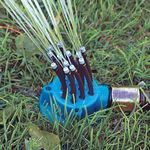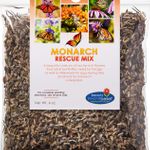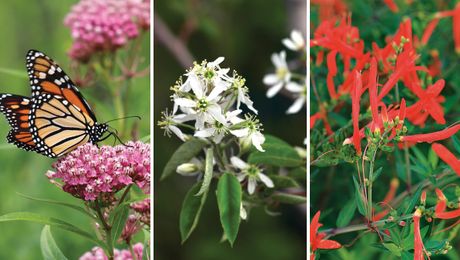
For some time, I’ve felt like Goldilocks in search of the perfect ornamental grass species: something that wasn’t too tall, too short, too colorful, with foliage that was just needle-like enough, and adapted to a wide range of site conditions. I wanted a native grass with the impact of giant feather grass (Celtica gigantea, Zones 5–8), the height and growth rate of Mexican feather grass (Nassella tenuissima, Zones 7–10), the clumpy and tidy habit of prairie dropseed (Sporobolus heterolepis, Zones 3–9), and the hardiness tolerance of at least Zone 6. Eventually, I found the grass that felt “just right”: ‘White Cloud’ muhly grass.
While many are familiar with straight species pink-blooming M. capillaris, ‘White Cloud’ is a pale-flowered selection with a slightly more upright form and later bloom time than its parent. There is some speculation, but no confirmation, that ‘White Cloud’ may be a hybrid between M. capillaris and M. sericea. And, although it was introduced by Superior Trees Nursery in Lee, Florida, this grass is an equally great choice for gardeners in other regions looking for a North American native to anchor their gardens. The species can be found growing in the wild in the open woodlands of Massachusetts, to acidic soils of the Ozarks, and into the grassy meadows along the Missouri River.
Much like the adaptable straight species, ‘White Cloud’ can handle a variety of conditions including low-nutrient soils, salt intrusion (within reason), heat, and humid climes. Once established, it can withstand periods of drought. Though full sun guarantees the best show of the white and airy inflorescences in late fall, it can handle some shade too. It’s not fussy by any stretch. Give it some water during the establishment period, sun, and some decently well-drained soil, and you’ll have spectacular plants that mature to 2 to 3 feet tall in no time. Keep in mind that with blooms, the plant will average around 4 feet in height.
‘White Cloud’ is a remarkably low-maintenance plant. Restrain yourself from late-fall pruning and you’ll be rewarded with arching stems and dried seed heads that add structure to your winter garden, provide birds with food for the lean season,
and give cover to overwintering insects. Do less, get more! If you can’t handle the awkwardness of the shoulder season, cut the plant down to about 4 inches above the ground in spring—but it’s not necessary.
In addition to its adaptability, this perennial grass shines in a variety of ornamental contexts. In larger gardens, use masses of them to mimic open prairies. Intersperse the plantings with tall and wiry flowering perennials such as cutleaf coneflower (Rudbeckia laciniata, Zones 3–9), or showcase it amid the late fall seed heads of prairie blazing star (Liatris pycnostachya, Zones 3–9) and compliment yourself on achieving planting-design genius reminiscent of Piet Oudolf. Position these plants so that the panicles capture western-setting sun. In a smaller-scale garden, place groups of three to five ‘White Cloud’ plants amid shorter perennials at the edge of a border so that you can admire them at a pathway edge. You really can’t go wrong with this grass.
Marissa Angell is a New York–based landscape architect and owner and founder of Angell Landscape Architecture.
Fine Gardening Recommended Products

Spear & Jackson 4930FZ Razorsharp Telescopic Tree Pruner
Fine Gardening receives a commission for items purchased through links on this site, including Amazon Associates and other affiliate advertising programs.

D&X Garden Sprinkler
Fine Gardening receives a commission for items purchased through links on this site, including Amazon Associates and other affiliate advertising programs.
- 12 flexible nozzles that you can set in any direction, simply bend hoses to customize new watering patterns - 360 degree coverage of 3000 sq. ft area
- 3.5 x 4 x 6 inches

Monarch Butterfly Rescue Wildflower Seeds 4 oz.
Fine Gardening receives a commission for items purchased through links on this site, including Amazon Associates and other affiliate advertising programs.



















Comments
Log in or create an account to post a comment.
Sign up Log in